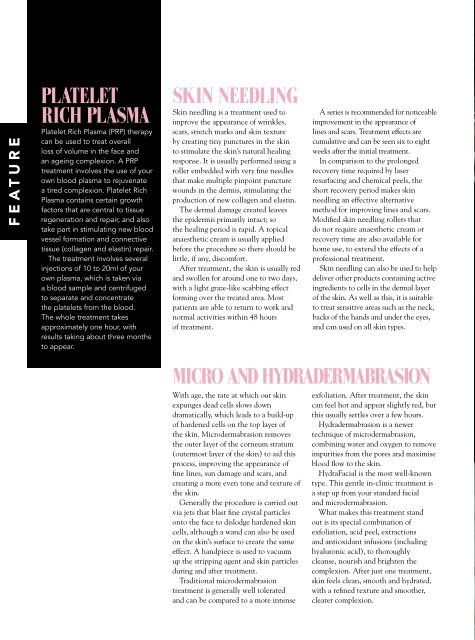CosBeauty Magazine #90
CosBeauty is the #BeautyAddict's guide to lifestyle, health and beauty in Australia and New Zealand. In this issue: - Summer Body; Meet this season's glow getters - 80+ Products to up your skincare game - 2020 Beauty lovers Christmas gift guide - Face-to-Face; the non-surgical tweakments turning heads
CosBeauty is the #BeautyAddict's guide to lifestyle, health and beauty in Australia and New Zealand.
In this issue:
- Summer Body; Meet this season's glow getters
- 80+ Products to up your skincare game
- 2020 Beauty lovers Christmas gift guide
- Face-to-Face; the non-surgical tweakments turning heads
You also want an ePaper? Increase the reach of your titles
YUMPU automatically turns print PDFs into web optimized ePapers that Google loves.
FEATURE<br />
PLATELET<br />
RICH PLASMA<br />
Platelet Rich Plasma (PRP) therapy<br />
can be used to treat overall<br />
loss of volume in the face and<br />
an ageing complexion. A PRP<br />
treatment involves the use of your<br />
own blood plasma to rejuvenate<br />
a tired complexion. Platelet Rich<br />
Plasma contains certain growth<br />
factors that are central to tissue<br />
regeneration and repair, and also<br />
take part in stimulating new blood<br />
vessel formation and connective<br />
tissue (collagen and elastin) repair.<br />
The treatment involves several<br />
injections of 10 to 20ml of your<br />
own plasma, which is taken via<br />
a blood sample and centrifuged<br />
to separate and concentrate<br />
the platelets from the blood.<br />
The whole treatment takes<br />
approximately one hour, with<br />
results taking about three months<br />
to appear.<br />
SKIN NEEDLING<br />
Skin needling is a treatment used to<br />
improve the appearance of wrinkles,<br />
scars, stretch marks and skin texture<br />
by creating tiny punctures in the skin<br />
to stimulate the skin’s natural healing<br />
response. It is usually performed using a<br />
roller embedded with very fine needles<br />
that make multiple pinpoint puncture<br />
wounds in the dermis, stimulating the<br />
production of new collagen and elastin.<br />
The dermal damage created leaves<br />
the epidermis primarily intact; so<br />
the healing period is rapid. A topical<br />
anaesthetic cream is usually applied<br />
before the procedure so there should be<br />
little, if any, discomfort.<br />
After treatment, the skin is usually red<br />
and swollen for around one to two days,<br />
with a light graze-like scabbing effect<br />
forming over the treated area. Most<br />
patients are able to return to work and<br />
normal activities within 48 hours<br />
of treatment.<br />
With age, the rate at which our skin<br />
expunges dead cells slows down<br />
dramatically, which leads to a build-up<br />
of hardened cells on the top layer of<br />
the skin. Microdermabrasion removes<br />
the outer layer of the corneum stratum<br />
(outermost layer of the skin) to aid this<br />
process, improving the appearance of<br />
fine lines, sun damage and scars, and<br />
creating a more even tone and texture of<br />
the skin.<br />
Generally the procedure is carried out<br />
via jets that blast fine crystal particles<br />
onto the face to dislodge hardened skin<br />
cells, although a wand can also be used<br />
on the skin’s surface to create the same<br />
effect. A handpiece is used to vacuum<br />
up the stripping agent and skin particles<br />
during and after treatment.<br />
Traditional microdermabrasion<br />
treatment is generally well tolerated<br />
and can be compared to a more intense<br />
A series is recommended for noticeable<br />
improvement in the appearance of<br />
lines and scars. Treatment effects are<br />
cumulative and can be seen six to eight<br />
weeks after the initial treatment.<br />
In comparison to the prolonged<br />
recovery time required by laser<br />
resurfacing and chemical peels, the<br />
short recovery period makes skin<br />
needling an effective alternative<br />
method for improving lines and scars.<br />
Modified skin needling rollers that<br />
do not require anaesthetic cream or<br />
recovery time are also available for<br />
home use, to extend the effects of a<br />
professional treatment.<br />
Skin needling can also be used to help<br />
deliver other products containing active<br />
ingredients to cells in the dermal layer<br />
of the skin. As well as this, it is suitable<br />
to treat sensitive areas such as the neck,<br />
backs of the hands and under the eyes,<br />
and can used on all skin types.<br />
MICRO AND HYDRADERMABRASION<br />
exfoliation. After treatment, the skin<br />
can feel hot and appear slightly red, but<br />
this usually settles over a few hours.<br />
Hydradermabrasion is a newer<br />
technique of microdermabrasion,<br />
combining water and oxygen to remove<br />
impurities from the pores and maximise<br />
blood flow to the skin.<br />
HydraFacial is the most well-known<br />
type. This gentle in-clinic treatment is<br />
a step up from your standard facial<br />
and microdermabrasion.<br />
What makes this treatment stand<br />
out is its special combination of<br />
exfoliation, acid peel, extractions<br />
and antioxidant infusions (including<br />
hyaluronic acid), to thoroughly<br />
cleanse, nourish and brighten the<br />
complexion. After just one treatment,<br />
skin feels clean, smooth and hydrated,<br />
with a refined texture and smoother,<br />
clearer complexion.

















